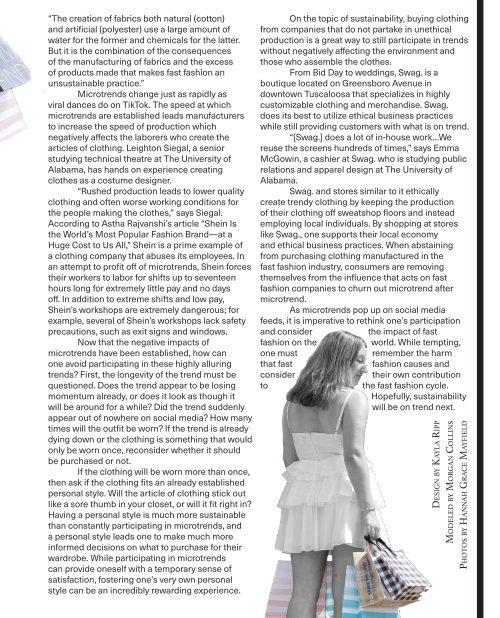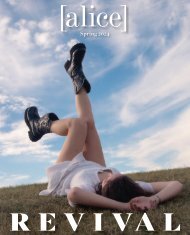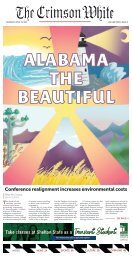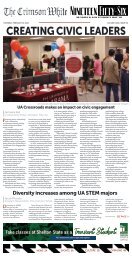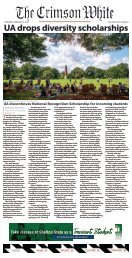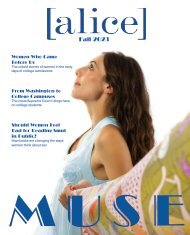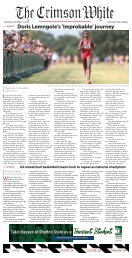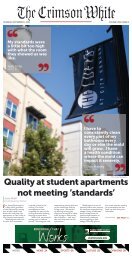Volume 9 Issue 1
The first issue of Volume 9 spotlights women, both past and present, who are leaving their mark through creativity. From historical women who blazed trails before us, to Supreme Court decisions that shape the lives of college students, and even the unapologetic act of reading smut in public spaces. Volume 9 Issue 1 is a tapestry that weaves together the threads of the past, present, and future, celebrating the power of artistic expression to provoke thought, challenge norms and ignite change.
The first issue of Volume 9 spotlights women, both past and present, who are leaving their mark through creativity. From historical women who blazed trails before us, to Supreme Court decisions that shape the lives of college students, and even the unapologetic act of reading smut in public spaces. Volume 9 Issue 1 is a tapestry that weaves together the threads of the past, present, and future, celebrating the power of artistic expression to provoke thought, challenge norms and ignite change.
Create successful ePaper yourself
Turn your PDF publications into a flip-book with our unique Google optimized e-Paper software.
“The creation of fabrics both natural (cotton)<br />
and artificial (polyester) use a large amount of<br />
water for the former and chemicals for the latter.<br />
But it is the combination of the consequences<br />
of the manufacturing of fabrics and the excess<br />
of products made that makes fast fashion an<br />
unsustainable practice.”<br />
Microtrends change just as rapidly as<br />
viral dances do on TikTok. The speed at which<br />
microtrends are established leads manufacturers<br />
to increase the speed of production which<br />
negatively affects the laborers who create the<br />
articles of clothing. Leighton Siegal, a senior<br />
studying technical theatre at The University of<br />
Alabama, has hands on experience creating<br />
clothes as a costume designer.<br />
“Rushed production leads to lower quality<br />
clothing and often worse working conditions for<br />
the people making the clothes,” says Siegal.<br />
According to Astha Rajvanshi’s article “Shein Is<br />
the World’s Most Popular Fashion Brand—at a<br />
Huge Cost to Us All,” Shein is a prime example of<br />
a clothing company that abuses its employees. In<br />
an attempt to profit off of microtrends, Shein forces<br />
their workers to labor for shifts up to seventeen<br />
hours long for extremely little pay and no days<br />
off. In addition to extreme shifts and low pay,<br />
Shein’s workshops are extremely dangerous; for<br />
example, several of Shein’s workshops lack safety<br />
precautions, such as exit signs and windows.<br />
Now that the negative impacts of<br />
microtrends have been established, how can<br />
one avoid participating in these highly alluring<br />
trends? First, the longevity of the trend must be<br />
questioned. Does the trend appear to be losing<br />
momentum already, or does it look as though it<br />
will be around for a while? Did the trend suddenly<br />
appear out of nowhere on social media? How many<br />
times will the outfit be worn? If the trend is already<br />
dying down or the clothing is something that would<br />
only be worn once, reconsider whether it should<br />
be purchased or not.<br />
If the clothing will be worn more than once,<br />
then ask if the clothing fits an already established<br />
personal style. Will the article of clothing stick out<br />
like a sore thumb in your closet, or will it fit right in?<br />
Having a personal style is much more sustainable<br />
than constantly participating in microtrends, and<br />
a personal style leads one to make much more<br />
informed decisions on what to purchase for their<br />
wardrobe. While participating in microtrends<br />
can provide oneself with a temporary sense of<br />
satisfaction, fostering one’s very own personal<br />
style can be an incredibly rewarding experience.<br />
On the topic of sustainability, buying clothing<br />
from companies that do not partake in unethical<br />
production is a great way to still participate in trends<br />
without negatively affecting the environment and<br />
those who assemble the clothes.<br />
From Bid Day to weddings, Swag. is a<br />
boutique located on Greensboro Avenue in<br />
downtown Tuscaloosa that specializes in highly<br />
customizable clothing and merchandise. Swag.<br />
does its best to utilize ethical business practices<br />
while still providing customers with what is on trend.<br />
“[Swag.] does a lot of in-house work…We<br />
reuse the screens hundreds of times,” says Emma<br />
McGowin, a cashier at Swag. who is studying public<br />
relations and apparel design at The University of<br />
Alabama.<br />
Swag. and stores similar to it ethically<br />
create trendy clothing by keeping the production<br />
of their clothing off sweatshop floors and instead<br />
employing local individuals. By shopping at stores<br />
like Swag., one supports their local economy<br />
and ethical business practices. When abstaining<br />
from purchasing clothing manufactured in the<br />
fast fashion industry, consumers are removing<br />
themselves from the influence that acts on fast<br />
fashion companies to churn out microtrend after<br />
microtrend.<br />
As microtrends pop up on social media<br />
feeds, it is imperative to rethink one’s participation<br />
and consider<br />
the impact of fast<br />
fashion on the<br />
world. While tempting,<br />
one must<br />
remember the harm<br />
that fast<br />
fashion causes and<br />
consider<br />
to<br />
their own contribution<br />
the fast fashion cycle.<br />
Hopefully, sustainability<br />
will be on trend next.<br />
Design by Kayla Ripp<br />
Modeled by Morgan Collins<br />
Photos by Hannah Grace Mayfield


